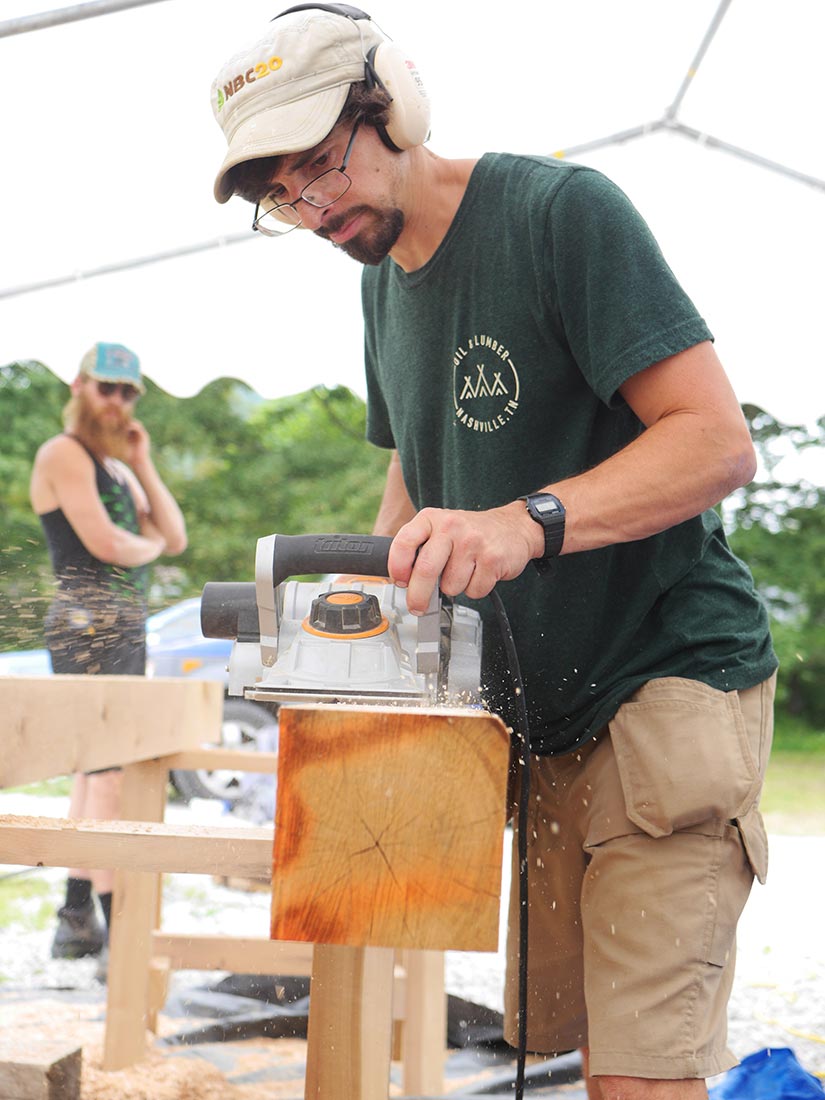If you’re thrifty and building a timber frame structure for yourself, you’re most likely going to buy green (or unseasoned) timbers from a local sawmill. If you’re lucky, you might acquire timbers from a bandsaw mill, which produces relatively clean cuts when compared to a circular sawmill. However, if you’re not partial to the rough sawn look and texture, you have a few options to smooth and finish the timbers. Perhaps the most economical option is to plane the timbers yourself, but how?
6×6, 8×8 and larger sized timbers can be intimidating to consider planing. There’s always a hand plane, but that is challenging work for more than a few pieces or tough wood like oak. I was faced with this dilemma and opted for the electric hand planer route, picking up a Triton TPL180. The TPL180 is a 7″ wide electric hand planer designed for large dimension lumber. Here are my impressions of the tool.
The 7″ Wide Electric Hand Planer: Triton TPL180
I very much appreciate planed wood. Rough sawn timbers have their place, but it’s not always what you want in a finished building. And the options for wide electric hand planers is limited from what I can tell. You basically have three options: a $600 6 3/4″ wide Makita planer, a $2000 (!) 12″ wide Makita, or a ~$230 7″ wide Triton. Hrrrmmm….
Having never personally used either of the Makita hand planers, I cannot and will not attempt to say anything about them. They were both out of budget for me. The Triton, at 7″ wide and just over $200 seems too good to be true. Surely it’s not the finest tool on the shelf, but I must say that it saved me both lots of time and dinero. And thus far, it’s delivered an acceptable cut.
Obviously the main attraction is the price. The tool itself feels just slightly cheap, especially the adjustment knob which is a little clunky. And out of the box, the calibration didn’t feel quite right. The cut wasn’t totally even across the width of the blade. The instructions are also about worthless. So figuring out how exactly to tweak the blades was an exercise in trial and error.
No, it’s not perfect, but I didn’t expect perfection, especially when the next most comparable tool is 2 1/2x the price, ya know?
What the tool did allow me to do is plane and smooth a big pile of 6×6 and 6×8 white oak timbers with relative ease. I’m satisfied with the results, even if it took some fussing. I guess some fussing is in order anyway, but I digress. And yes, the tool is heavy. Of course it is. It’s the mass of the tool that keeps it from moving all over the place. Frankly, once it’s laid on the timber and powered on, the weight isn’t half bad. It’s mostly heavy when you’re moving it about and lifting it up at the end of a cut.
Anyway… seeing as how the options for large electric hand planers is quite limited, I figured I’d give the Triton TPL80 a little shout-out. For less than the cost of a brand new jack plane, you can get yourself a respectable 7″ electric planer capable of smoothing your stack of timbers with nice results.





Thanks for the review, I always appreciate tool talk written from actual experience. I thought this planer worked pretty well and was fairly easy to use, once you’d dialed it in, though I remember that dial-in being quite a process. I know you have a large stationary planer/jointer in your workshop, but I’m wondering about material wider than these timbers—if I’m building something like a dining table out of 30″ wide slab wood from a sawmill (that will have invariably dried a bit cupped, twisted, etc.), would this Triton be useful in getting it smoothed out, or would you think a large hand plane (or large industrial planer) would be more appropriate? And on the other side of that coin, this planer may not be that useful for fine / “furniture” grade planing? if you were making cabinetry or something out of smaller, thinner boards, I’d think you’d almost have to use a stationary planer for that, or could you use this with the material clamped down?
I don’t consider this Triton planer a finish tool (for fine woodworking), but you could certainly use it to help speed up the flattening process of a wide slab. You would ultimately want to use a smoothing plane to achieve a higher quality finish. A hand plane will do the same thing (flattening) in more time.
For narrower boards that will be laminated, the easiest thing is to run them all through a stationary planer at the same thickness setting and then glue them up, and finally clean the lamination with a smoothing planer, scraper, sander, etc. The lamination should be accurate to the point where you’re not hogging off a ton of material.
Does that make sense?